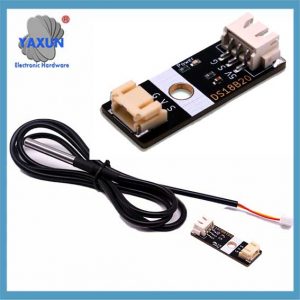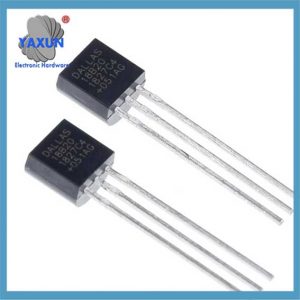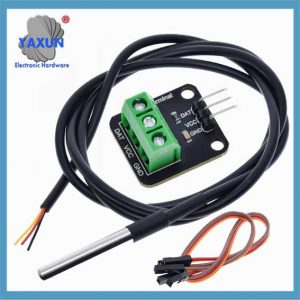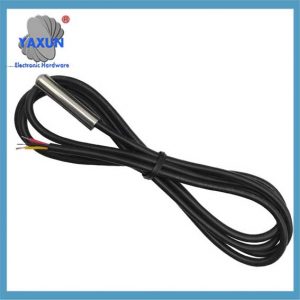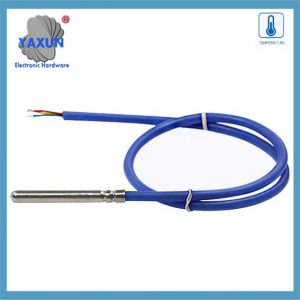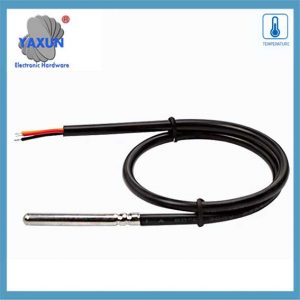We offer a wide range of the best 1-Wire DS18B20 sensor connectors, including Nanoflex, DisplayPort, USB, Solar, SATA, HDMI, ATA IDE, SAS & many more. All cables are manufactured to the highest industry standards. Using Sensor Circuit Assembly for box builds allows you to focus on your design and marketing, reduce costs, and reap the benefits of our assembly lines, QA processes, and manufacturing expertise.
The DS18B20 sensor communicates using the “1-Filo” protocol, which means it uses a single data line for all communication with a microcontroller, allowing multiple sensors to be connected on the same line and identified by their unique 64-bit serial code; this single data line is pulled high with a resistor and the sensor transmits data by pulling the line low during specific time slots to send bits of information.
Sensore di temperatura DS18B20: The DS18B20 waterproof probe is designed for underwater use, capable of operating in wet or moist environments without being damaged by water or moisture.
Temperature sensor supply voltage: 3.0V ~ 5.25V;
Intervallo di temperatura operativa:-55 ℃ a +125 ℃ (-67 ℉ to +257 ℉);
Provides from 9-bit to 12-bit Celsius temperature measurements;
Adapter module is equipped with a pull-up resistor, and directly connects to the GPIO of the Raspberry Pi without an external resistor;
Use this adapter module kit to simplify connecting the waterproof temperature sensor to your project.
1. Key points about the 1-Wire protocol:
Single data line:
Only one wire is needed for communication between the sensor and the microcontroller.
Half-duplex communication:
Data can be sent in both directions, but only one direction at a time.
Parasite power:
The DS18B20 can be powered directly from the data line during communication, eliminating the need for a separate power supply in some cases.
Unique device addresses:
Each DS18B20 sensor has a unique 64-bit serial code that allows the microcontroller to identify and address individual sensors on the bus.
Communication steps with a DS18B20:
1.1 Reset pulse:
The microcontroller initiates communication by pulling the data line low for a specific duration (reset pulse).
1.2 Presence pulse:
If a DS18B20 is present on the bus, it will respond with a short pulse, indicating its presence.
1.3 ROM command:
The microcontroller sends a ROM command to either read the unique 64-bit code of a specific sensor (“Match ROM”) or to address all sensors on the bus (“Camera delle navi”).
1.4 Function command:
Depending on the desired operation (like reading temperature), the microcontroller sends a specific function command to the sensor.
1.5 Data transfer:
Data is transmitted bit-by-bit, with the sensor pulling the data line low to send a ‘0’ and letting the line go high to send a ‘1’.
2. Spiegazione dettagliata del protocollo di comunicazione a 1 filo di DS18B20
Il motivo per cui i sensori DS18B20 sono ampiamente utilizzati è in gran parte dovuto al suo protocollo di comunicazione unico – 1-Protocollo di comunicazione Wire. Questo protocollo semplifica i requisiti per le connessioni hardware e fornisce un modo efficiente per trasmettere dati. Questo capitolo analizzerà profondamente il meccanismo di lavoro e il processo di scambio di dati del protocollo di comunicazione a 1 linea per porre una solida base per la successiva pratica di programmazione.
2.1 Nozioni di base sul protocollo di comunicazione a 1 filo
2.1.1 Caratteristiche del protocollo di comunicazione a 1 filo:
Il protocollo di comunicazione a 1 filo DS18B20 è anche chiamato “singolo autobus” tecnologia. Ha le seguenti funzionalità: – Comunicazione per autobus singolo: Viene utilizzata una sola linea di dati per la trasmissione di dati bidirezionale, che riduce notevolmente la complessità del cablaggio rispetto al tradizionale metodo di comunicazione del sensore multi-filo. – Connessione multi-dispositivo: Supporta la connessione di più dispositivi su un bus dati, e identifica e comunica attraverso i codici di identificazione del dispositivo. – Basso consumo energetico: Durante la comunicazione, Il dispositivo può essere in uno stato di standby a bassa potenza quando non partecipa alla comunicazione. – Alta precisione: Con un tempo di trasmissione dei dati più breve, Può ridurre l'interferenza esterna e migliorare l'accuratezza dei dati.
2.1.2 Formato dei dati e analisi di temporizzazione della comunicazione a 1 filo
Il formato dei dati del protocollo di comunicazione a 1 filo segue una regola di temporizzazione specifica. Include i tempi di inizializzazione, Scrivi i tempi e leggi i tempi:
Tempistica di inizializzazione: L'host inizia prima i tempi di rilevamento della presenza (Pulse di presenza) Tirando giù l'autobus per un certo periodo di tempo, e il sensore invia quindi un impulso di presenza in risposta.
Scrivi i tempi: Quando l'host invia un tempismo di scrittura, prima tira giù l'autobus per circa 1-15 microsecondi, Quindi rilascia l'autobus, e il sensore tira giù l'autobus 60-120 Microsecondi per rispondere.
Leggi i tempi: L'host avvisa il sensore di inviare dati tirando giù il bus e rilasciandoli, e il sensore emetterà il bit di dati sul bus dopo un certo ritardo.
2.2 Software implementation of data communication
2.2.1 Initialization and reset of 1-line communication
At the software level, initialization and reset of 1-Wire communication is the first step of communication. The following is the pseudo code to implement this process:
// OneWire communication initialization function
void OneWire_Init() {
// Set the bus to input mode and enable the pull-up resistor
SetPinMode(DS18B20_PIN, INPUT_PULLUP);
// Wait for the bus to be idle
DelayMicroseconds(1);
// Send a reset pulse
OneWire_Reset();
}
// OneWire communication reset function
void OneWire_Reset() {
// Pull down the bus
SetPinMode(DS18B20_PIN, OUTPUT_LOW);
DelayMicroseconds(480);
// Release the bus
SetPinMode(DS18B20_PIN, INPUT_PULLUP);
DelayMicroseconds(70);
// Wait for the presence of a pulse
Se (!WaitForOneWirePresence())
// No pulse was detected, maybe the sensor is not connected or the initialization failed
HandleError();
DelayMicroseconds(410);
}
// Waiting for the presence of a pulse
bool WaitForOneWirePresence() {
return ReadPin(DS18B20_PIN) == 0; // Assume low level is a signal presence
}
2.2.2 Data reading and writing operations
Data reading and writing operations are the core part of sensor communication. The following code shows how to write a byte to a one-wire bus:
// Write a byte to a one-wire bus
void OneWire_WriteByte(byte data) {
per (int i = 0; io < 8; I ++) {
OneWire_WriteBit(dati & 0X01);
dati >>= 1;
}
}
// Write a bit to a one-wire bus
void OneWire_WriteBit(bit data) {
SetPinMode(DS18B20_PIN, OUTPUT_LOW);
Se (dati) {
// Release the bus when writing 1
SetPinMode(DS18B20_PIN, INPUT_PULLUP);
DelayMicroseconds(1);
} altro {
// Continue to pull the bus low when writing 0
DelayMicroseconds(60);
}
SetPinMode(DS18B20_PIN, INPUT_PULLUP);
DelayMicroseconds(1);
}
Next is the function to read a byte:
// Read a byte from the one-wire bus
byte OneWire_ReadByte() {
byte data = 0;
per (int i = 0; io < 8; I ++) {
dati >>= 1;
Se (OneWire_ReadBit())
dati |= 0x80;
}
restituire dati;
}
// Read a bit from the one-wire bus
bit OneWire_ReadBit() {
SetPinMode(DS18B20_PIN, OUTPUT_LOW);
SetPinMode(DS18B20_PIN, INPUT_PULLUP);
DelayMicroseconds(3);
bool result = ReadPin(DS18B20_PIN);
DelayMicroseconds(57);
return result;
}
2.2.3 Verification mechanism of OneWire communication
The OneWire communication protocol uses a simple verification mechanism in the data exchange process, usually by reading back the written data to verify the correctness of the data. The following is a sample code for verifying the written data:
byte data = 0x55; // Assume that the data to be sent
OneWire_WriteByte(dati); // Write data to the OneWire bus
byte readData = OneWire_ReadByte(); // Read back data from the OneWire bus
Se (readData != data) {
HandleError(); // If the read-back data does not match the written data, handle the error
 English
English العربية
العربية Български
Български 粤语
粤语 中文(简体)
中文(简体) 中文(漢字)
中文(漢字) Nederlands
Nederlands Suomi
Suomi Français
Français Deutsch
Deutsch Ελληνικά
Ελληνικά Magyar
Magyar Italiano
Italiano 日本語
日本語 한국어
한국어 Polski
Polski Português
Português Română
Română Русский
Русский Slovenščina
Slovenščina Español
Español Svenska
Svenska ภาษาไทย
ภาษาไทย Türkçe
Türkçe Tiếng Việt
Tiếng Việt

